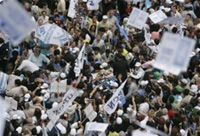Argentina: Violent clashes spoil the reburial of Peron’s remains
Armed groups clashed at the gates of the mausoleum were the country’s late strongman was reburied, leaving more than 50 injured. Peron died in 1974 but his body has been subject of disputes among his followers since then.

Serious clashes between different armed groups Tuesday spoiled the ceremony organized by labor unions affiliated to the Peronist Party to rebury the remains of the three times president of Argentina Gen. Juan Domingo Peron in a new mausoleum built in a weekend retreat once owned by Peron and his famous wife Evita. As a procession carrying Peron’s coffin was reaching the mausoleum located in the suburban town of San Vicente, some 50 kilometers southwest of Buenos Aires, armed bandits presumably linked to rival unions opened fire after arguing at the gates of the memorial.
Argentine President Nestor Kirchner - himself a devoted Peronist - was supposed to head the ceremony, but declined to attend after getting noticed of the shootout that left at least 50 wounded. Since very early in the morning, th ousands of admirers of Peron greeted his remains as his coffin was moved through clogged streets of Buenos Aires for reburial.
Peron had died in July 1974, less than one year after he was elected president for a third time. He was buried at the Presidential residence of Olivos, but his remains were relocated to a public cemetery after a military coup toppled the constitutional government lead by his second wife, Maria Estela Martinez, who succeeded Peron after he passed away. In 1987, an unidentified group violated Peron’s grave and cut out his hands, in an event that has not been clarified yet.
In 2004, a group of Peronist leaders headed by the former President Eduardo Duhalde (2002-2003) decided to build a mausoleum to re-bury Peron and his glamorous wife Evita, whose body rests at the traditional cemetery of Recoleta, also in Buenos Aires. Lately, the $1,3 million idea was blessed by Duhalde’s successor, Kirchner, who was expected to attend on Tuesday but stayed at the Palace of Government watching the clashes by TV.
Argentina, and specially the Peronist Party, has a long tradition of doing politics with the dead bodies of their leaders. When Evita died during the second presidency of Peron in 1952, her body was mummified and exhibited to huge crowds that used to love her. When military leaders overthrew Juan Peron in 1955, they were apparently so worried about a death cult that they secretly moved Evita's body to an unmarked grave in Italy. In 1971 it was delivered to Juan Peron's home in exile in Spain. One year before, a Peronist armed group, Montoneros, had hijacked the body of Gen. Aramburu, one of the leaders of the military uprising that toppled Peron, to claim for Evita’s one.
In 1989, the then-conservative President - also a Peronist - Carlos Menem repatriated to Argentina the remains of Gen. Rosas, who had ruled the country with an iron fist in the early 1800’s. The decision sparked an angry debate between admirers and detractors of the former dictator.
In phone calls to the main radio stations, Argentine citizens remembered the events of 1973, when Peron returned to Argentina after a 18-year-long political exile. At that time, a 3 million crowd gathered in the surrounding areas of the Ezeiza International Airport to wait for their leader. Officially 13 people died and 365 were wounded after different Peronist groups clashed.
Peron dominated Argentine politics all along the second half of the 20th century,. He was elected president three times: in 1946, 1952 and 1973. Peron cultivated an enormous working-class following by redirecting agricultural wealth to legions of urban poor through projects to build schools, hospitals and homes. He was later accused of pro-Nazi activities during his first presidency, when hundreds of German war criminals found shelter in Argentina.
Hernan Etchaleco
Pravda.ru
Subscribe to Pravda.Ru Telegram channel, Facebook, RSS!


